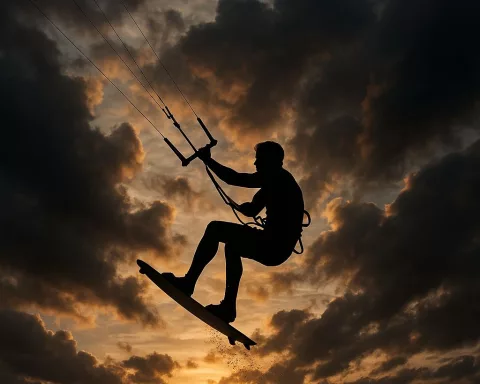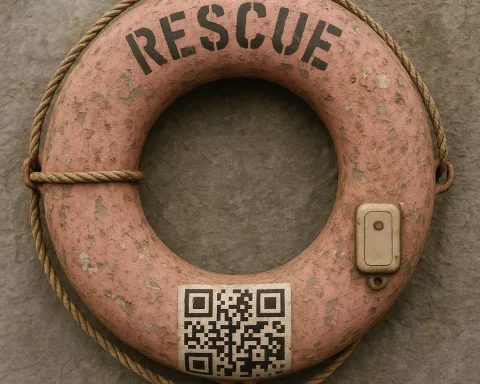The NSRI heroically rescued two surf skiers stranded in dangerous seas, battling severe weather conditions to retrieve the hypothermic men and their surf-ski. With the help of NSRI’s expertise and innovation, the vigilant team successfully secured the surf-ski against relentless winds and turbulent waters. The daring rescue serves as a testament to the importance of preparedness and the bravery and teamwork of the NSRI.
NSRI’s expertise and innovation were put to the test when they received an emergency call to rescue two surf skiers stranded in treacherous seas. Despite severe weather conditions, the vigilant NSRI team successfully retrieved the hypothermic skiers and hauled their surf-ski onto the rescue vessel, securing it against the relentless winds and turbulent waters. This heroic tale serves as a testament to the importance of preparedness and the courage, determination, and teamwork displayed by NSRI.
Part One: A Call to Arms in Treacherous Seas
In the turbulent expanse between Simon’s Town and Miller’s Point, two surf skiers found themselves caught in a perilous struggle with the relentless sea. The National Sea Rescue Institute (NSRI) in South Africa got an emergency call, marking the start of a rescue operation that would put their expertise and innovation to the test.
A vigilant onlooker had initially sounded the alarm. Despite the rapidly decreasing visibility and the howling gale, the observer noticed the two skiers stranded in the merciless wrath of the sea. Moreover, the skiers had the foresight to use the vital SafeTrx app to send out a distress signal, thereby increasing their survival odds.
Andrew de Kock, the station commander for NSRI Simon’s Town, narrated the heart-stopping sequence of events. As the rescue unit neared the scene, they had to contend with severe weather conditions. The dwindling light was further obscured by the nearly blinding sea mist. The setting was marked by foamy wind chop waves and swells measuring 1 to 1.5 meters, while gale-force winds contributed to the chaotic scenario.
Part Two: A Dire Situation Meets A Determined Response
The condition of the surf skiers was critical. While one man was barely clinging to the surf ski, his mate was grappling with the freezing sea water, showing clear symptoms of severe hypothermia, reported De Kock. The duo had let go of one of their paddles, and was using the other to flag their location to the rapidly approaching rescue vessel.
Confronted with the grim reality, the rescue team deployed NSRI’s rigid-hull inflatable boat and another vessel named Jack&Irene to maximize resources for the mission. However, the gravity of the situation was such that during its first attempt, the rescue ship was pushed away by the fierce wind and waves.
Regardless of the overwhelming winds and waves, the NSRI team didn’t budge. With admirable persistence, they successfully positioned their vessel within a manageable range of the two men. De Kock recalled how one of the rescue divers, with the help of a safety rope, swam to the surf ski’s stern, aiding the severely hypothermic man onto the platform and into the warm wheelhouse for restorative treatment.
Part Three: Triumph Over Turbulence
By this time, another rescue swimmer had returned to the surf-ski, managing to stabilize it under the demanding conditions. Together, they wrestled the surf-ski to the back of the rescue vessel. With the help of NSRI’s deck crew, they hauled the surf-ski onto the rescue vessel, securing it against the relentless winds and turbulent waters.
As De Kock pointed out, the surf-skiers, who were local adult males and seasoned extreme sports surf-skiers, were praised for their wise use of the NSRI SafeTrx app. Nevertheless, a combination of a snapped rudder cable, choppy seas, and strong winds had thrust them into such peril.
Part Four: A Testament to Bravery and Preparedness
This frightening tale of rescue serves to highlight the courage, determination, and teamwork displayed by the NSRI team, who battled challenging weather conditions and seemingly insurmountable odds to ensure the safe retrieval of the two surf skiers. It’s a stark reminder of the formidable power of nature and the crucial need for readiness when participating in high-risk sports.
1. What is the NSRI?
The National Sea Rescue Institute (NSRI) is an organization in South Africa that is dedicated to saving lives on South African waters.
2. What happened in this particular rescue operation?
The NSRI received an emergency call to rescue two surf skiers who were stranded in dangerous seas. Despite severe weather conditions, the vigilant NSRI team successfully retrieved the hypothermic skiers and hauled their surf-ski onto the rescue vessel, securing it against the relentless winds and turbulent waters.
3. What factors contributed to the difficulty of the rescue operation?
The rescue operation was made difficult by severe weather conditions including howling winds and nearly blinding sea mist. The setting was marked by foamy wind chop waves and swells measuring 1 to 1.5 meters, while gale-force winds contributed to the chaotic scenario.
4. How did the NSRI manage to rescue the surf skiers?
The NSRI deployed its rigid-hull inflatable boat and another vessel named Jack&Irene to maximize resources for the mission. The rescue team successfully positioned their vessel within a manageable range of the two men, and with the help of a safety rope, a rescue diver swam to the surf ski’s stern, aiding the severely hypothermic man onto the platform and into the warm wheelhouse for restorative treatment. Another rescue swimmer stabilized the surf-ski and together they hauled it onto the rescue vessel.
5. What was the condition of the surf skiers when they were rescued?
The condition of the surf skiers was critical. While one man was barely clinging to the surf ski, his mate was grappling with the freezing sea water, showing clear symptoms of severe hypothermia.
6. What lessons can be learned from this rescue operation?
This rescue operation serves as a testament to the importance of preparedness and the courage, determination, and teamwork displayed by the NSRI team. It’s a stark reminder of the formidable power of nature and the crucial need for readiness when participating in high-risk sports. The surf-skiers were praised for their wise use of the NSRI SafeTrx app, which helped to increase their survival odds.











